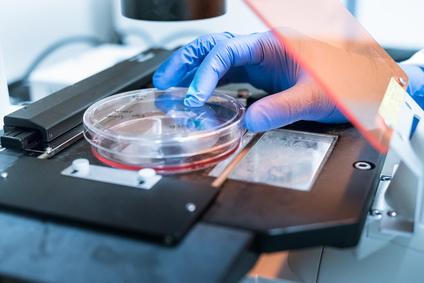Biofilm Investigation: What Is Under the Microscope?
January 1, 2018
Biofilm Morphology and Function
Have you ever had plaque buildup on your teeth, seen a thin clear film on the top of your pet's water bowl, or stepped into a locker room shower where the floor felt slick and slimy? If so, then did you realize these were all forms of biofilm? Biofilm is a complex microbial community containing self- and surface-attached microorganisms that are embedded in an extracellular polymeric substance, or EPS.1,2 The EPS is the slimy substance in the previous examples and is primarily a polysaccharide protective matrix synthesized and secreted by the microorganisms that attaches the biofilm firmly to a living or non-living surface. This film protects the organisms from destruction first by being tenacious and keeping the microbial community strongly attached to a surface.
Although the organisms in biofilm are microscopic, when biofilm is allowed to grow for extended periods of time and remains undisturbed, it becomes visible. This can happen in as little as 24 hours. Some organisms produce pigments that make them more easily identifiable. For example, Pseudomonas aeruginosa produces pyocyanin, which gives the bacterium a distinctive green color. However, we must remember that just because a wound has green drainage, it does not always mean that Pseudomonas is growing in the wound.3 The EPS coating of biofilm also does not allow the body's immune system to recognize the presence of the microorganism; therefore, the bacteria evade an immune response, avoid detection by standard diagnostic techniques, and avoid destruction by standard treatments and therapies.4
Detection of Biofilm-Associated Infection
Biofilms are resistant to biocides and are known causative agents of medical device-related infections and chronic infections.5 Although attempts are under way, so far there has not been a laboratory test developed that can identify or diagnose a biofilm-associated infection. Two of the more successful organisms identified as being able to develop biofilms are Staphylococcus aureus (gram positive) and P. aeruginosa (gram negative). Syskin et al.5 have attempted to develop a quantitative laboratory assay for biofilm-associated organisms. These investigators noted that because this assay took into account only two organisms, more studies are needed for quantitation of biofilm formation by other organisms. This issue is very important because the prevalence of chronic and medical device-associated infections in the United States has skyrocketed, and the impact on clinical and financial outcomes is enormous.5
A Microscopic World of Many Species
Biofilms are not made up just of bacteria. Research has shown that all species of microorganisms, and in addition to bacteria, viruses, yeast, and fungi, have the ability to develop biofilm and adhere to surfaces and each other. For example, studies show that as many as 300 different species of bacteria can inhabit biofilm in dental plaque.6 Wound biofilm may have either a single microbial or multimicrobial origin, and microbial diversity in a wound can be affected by wound location and characteristics, but not necessarily by wound type.7
Even though numerous studies have been completed on biofilms, the exact mechanisms that result in delayed wound healing are not clearly understood and are still under investigation. It is thought that biofilms delay healing by compromising and evading the body's immune response and by causing damage to host cells. Research verified, however, that biofilms play a detrimental role in many chronic illnesses, such as cystic fibrosis, sinusitis, and infections related to indwelling medical devices.
It has also been shown in studies that DNA sequencing gives more information on the microbial makeup of biofilms in chronic wounds, their production, and their ability to promote infection.7 The same study also discussed how the consumption of oxygen by aerobic bacteria in biofilm promoted the production of anaerobic bacteria in the biofilm. Determination of biofilm's existence in a wound is not an easy feat because currently no diagnostic tests are available.7 Visual assessment many times causes slough, debris, and exudate to be mistaken for biofilm. Tools such as tissue biopsies are more reliable than swab specimens and cultures to determine biofilm in wounds, but results of routine cultures are not definitive. The combination of approaches is necessary to make an accurate determination of biofilm's presence.
Conclusion
Further research is needed on methods, diagnostic test, tools, and devices to identify the presence of biofilm, as well as the communal organisms it contains. This will be the first step in establishing guidelines for prevention and treatment strategies addressing biofilm and wound management, thus subsequently reducing the risk of resulting infections. Understanding the appropriateness and accuracy of assessment and monitoring of wounds will improve wound healing outcomes and will result in decreased use of clinical and financial resources.
References:
1. Barker JC, Khansa I, Gordillo G. A formidable foe is sabotaging your results: what you should know about biofilms and wound healing. Plast Reconstr Surg. 2017;139(5):1184094.
2. Hurlow J. Understanding biofilm: what a community nurse should know. Br J Community Nurs. 2016;21(9):26-33.
3. Phillips PL, Wolcott RD, Fletcher J, Schultz GS. Biofilms made easy. Wounds Int. 2010;1(3). Available at: http://www.woundsinternational.com/made-easys/view/biofilms-made-easy
4. Song T, Duperthuy M, Wai SN. Sub-optimal treatment of bacterial biofilms. Antibiotics. 2016;5(2):23.
5. Syskin E, Tran L, Duessel S, Heuertz RM. Bacterial biofilm assay for the clinical laboratory. Clin Lab Sci. 2017;30(3):155-60.
6. Roy S, Elgharably H, Sinha M, et al. Mixed-species biofilm compromises wound healing by disrupting epidermal barrier function. J Pathol. 2014;233(4):331-43.
7. Schultz G, Bjarnsholt T, James GA, et al.; Global Wound Biofilm Expert Panel. Consensus guidelines for the identification and treatment of biofilms in chronic non-healing wounds. Wound Repair Regen. 2017;25(4):1-50.
The views and opinions expressed in this blog are solely those of the author, and do not represent the views of WoundSource, HMP Global, its affiliates, or subsidiary companies.












Follow WoundSource
Tweets by WoundSource